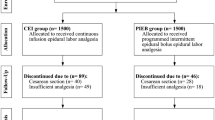Abstract
Objectives
The combined spinal–epidural analgesia (CSEA) technique for labor pain has attained wide spread popularity in obstetric anesthesia. The onset of analgesia is rapid and reliable, and maternal satisfaction is very high. However, the best timing of an epidural infusion following the spinal dose and its effect on the total local anesthetics consumption has not been well determined.
Methods
A total of 144 consenting healthy nulliparous parturients whose labor was induced and who labored under regional analgesia were enrolled in this study. Following induction of the CSEA with intrathecal injection of bupivacaine, 2.5 mg and fentanyl, 25 μg, the patients were randomized into one of four groups to receive a subsequent continuous epidural infusion [E (3), E (30), E (60) and E (90)], depending on the timing of the initiation of epidural infusion of 0.1% ropivacaine, 0.0002% fentanyl and 1:500,000 epinephrine at the rate of 10 ml/h. In study Groups E (3), E (30), E (60) and E (90), epidural infusion was initiated 3, 30, 60 and 90 min, respectively following spinal induction dose. Patients requesting additional labor analgesia were given an epidural bolus (8 ml) of ropivacaine, 0.2%. The number of parturients requesting additional boluses of ropivacaine and the total dose of ropivacaine required for labor analgesia were registered.
Results
The numbers of patients who required additional boluses of ropivacaine in Group E (3) and Group E (30) were significantly less than those in Group E (60) and Group E (90). The total dose of ropivacaine required for labor pain in Group E (3) and Group E (30) was insignificantly smaller than the total dose required in Group E (60) and Group E (90).
Conclusion
Our results suggest that the best timing of epidural infusion following spinal dose was within 30 min of spinal induction dose.
Similar content being viewed by others
References
Kuczkowski KM (2007) Labor pain and its management with the combined spinal–epidural analgesia: what does an obstetrician need to know? Arch Gynecol Obstet 275:183–185. doi:10.1007/s00404-006-0204-5
Kuczkowski KM (2004) Ambulation with combined spinal–epidural labor analgesia: the technique. Acta Anaesthesiol Belg 55:29–34
Collins RE, Davies DWL, Aveling W (1995) Randomised comparison of combined spinal–epidural and standard epidural analgesia in labour. Lancet 345:1413–1416. doi:10.1016/S0140-6736(95)92602-X
Collis RE, Baxandall ML, Srikantharajah ID, Edge G, Kadim MY, Morgan BM (1994) Combined spinal epidural (CSE) analgesia: technique, management, and outcome of 300 mothers. Int J Obstet Anesth 3:75–81. doi:10.1016/0959-289X(94)90173-2
Sah N, Vallejo MC, Ramanathan S, Golebiewski K (2005) Bupivacaine versus l-bupivacaine for labor analgesia via combined spinal–epidural: a randomized, double-blinded study. J Clin Anesth 17:91–95. doi:10.1016/j.jclinane.2004.05.004
Sia AT, Ruban P, Chong JL, Wong K (1999) Motor blockade is reduced with ropivacaine 0.125% for parturient-controlled epidural analgesia during labour. Can J Anaesth 46:1019–1023
Pace MC, Aurilio C, Bulletti C, Iannotti M, Passavanti MB, Palagiano A (2004) Subarachnoid analgesia in advanced labor: a comparison of subarachnoid analgesia and pudendal block in advanced labor: analgesic quality and obstetric outcome. Ann N Y Acad Sci 1034:356–363. doi:10.1196/annals.1335.037
Teoh WH, Sia AT (2003) Hyperbaric bupivacaine 2.5 mg prolongs analgesia compared with plain bupivacaine when added to intrathecal fentanyl 25 microg in advanced labor. Anesth Analg 97: 873–877. doi: 10.1213/01.ANE.0000076388.17223.37
Goodman SR, Kim-Lo SH, Ciliberto CF, Ridley DM, Smiley RM (2002) Epinephrine is not a useful addition to intrathecal fentanyl or fentanyl–bupivacaine for labor analgesia. Reg Anesth Pain Med 27:374–379. doi:10.1053/rapm.2002.33283
Yeh HM, Chen LK, Shyu MK, Lin CJ, Sun WZ, Wang MJ et al (2001) The addition of morphine prolongs fentanyl–bupivacaine spinal analgesia for the relief of labor pain. Anesth Analg 92:665–668. doi:10.1097/00000539-200103000-00022
Okutomi T, Saito M, Hoka S, Mochizuki J, Amano K (2004) The effect of timing in the initiation of epidural infusion at combined spinal–epidural analgesia for labor on the total dose of local anesthetic. Anesthesiology 101:A1225. doi:10.1097/00000542-200411000-00024
Atienzar MC, Palanca JM, Borras R, Esteve I, Fernandez M, Miranda A (2004) Ropivacaine 0.1% with fentanyl 2 microg mL (−1) by epidural infusion for labour analgesia. Eur J Anaesthesiol 21:770–775. doi:10.1017/S0265021504000031
Lee BB, Ngan Kee WD, Lau WM, Wong AS (2000) Epidural infusions for labor analgesia: a comparison of 0.2% ropivacaine, 0.1% ropivacaine, and 0.1% ropivacaine with fentanyl. Reg Anesth Pain Med 27:31–36. doi:10.1053/rapm.2002.27836
James KS, McGrady E, Quasim I, Patrick A (1998) Comparison of epidural bolus administration of 0.25% bupivacaine and 0.1% bupivacaine with 0.0002% fentanyl for analgesia during labour. Br J Anaesth 81:507–510
Chestnut DH, Owen CL, Bates JN (1988) Continuous infusion epidural analgesia during labor: a randomized, double-blind comparison of 0.0625% bupivacaine/0.0002% fentanyl versus 0.125% bupivacaine. Anesthesiology 68:754–759
Norris MC (2000) Are combined spinal–epidural catheters reliable? Int J Obstet Anesth 9:3–6. doi:10.1054/ijoa.1999.0301
Gaiser RR, Lewin SB, Cheek TG, Gutsche BB (2000) Effects of immediately initiating an epidural infusion in the combined spinal and epidural technique in nulliparous parturients. Reg Anesth Pain Med 25:223–227. doi:10.1016/S1098-7339(00)90002-6
Author information
Authors and Affiliations
Corresponding author
Rights and permissions
About this article
Cite this article
Okutomi, T., Saito, M., Mochizuki, J. et al. Combined spinal–epidural analgesia for labor pain: best timing of epidural infusion following spinal dose. Arch Gynecol Obstet 279, 329–334 (2009). https://doi.org/10.1007/s00404-008-0725-1
Received:
Accepted:
Published:
Issue Date:
DOI: https://doi.org/10.1007/s00404-008-0725-1




